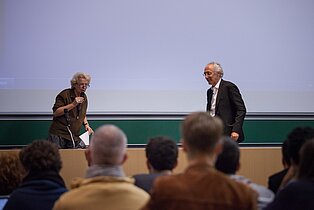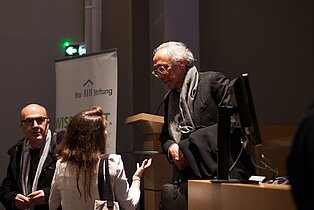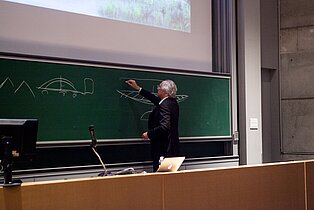Marc Mimram | Marc Mimram | Paris
Marc Mimram: The circumstances of the creation
Marc Mimram has completed two courses of study: He is an architect and a civil engineer. Since his office was founded in 1981, he has put in place many building construction and infrastructure projects in France and all across the world. It appears that his dual track capability has given him a discerning calmness with regard to the viewpoints and creations of his colleagues in both professions – architects as well as civil engineers. It has obviously helped him avoid the errors that both professions are accused of. The hybrid occupation and the resulting insights have made it possible for Mimram to tackle the problems of “building elsewhere” with particular creativity and expertise.
To Marc Mimram, the “elsewhere” is a component of project-oriented thinking. That’s what he says at the start of his conference “The project begins elsewhere” and illustrates his statement with pictures of enormous mineral mining deposits. The question about the origin of building materials causes the civil engineer to ponder how he is responsible for how the world changes. This feeling of responsibility with regard to the complexity of a contemporary project (technical, economic, geographic, social, ecological and design-related challenges) has led Mimram to neglect the pursuit of achieving daring accomplishments that drives many engineers. He is not interested in building increasingly higher, slimmer and lighter. Instead, he prefers taking into consideration the holistic achievement of a design and reminds us, for example, that the use of aluminium, a material with excellent physical properties, remains controversial in light of its production and recycling conditions.
In addition to his missing enthusiasm for the achievement as such, Mimram also stands out as a result of rejecting standardised constructive solutions, for example the “Bridge of the shelf”, which has become standard since its technical performance and efficiency have been proven. Mimram primarily seeks to ensure that his projects develop a rich and meaningful relationship to their locations, as a result of which they seem to be completely entrenched in their territory after being built.
A lot of architects want to create projects that are rooted within their context. However, the design is often limited to providing the project with a “regional coat of paint” by weaving references to ornaments, styles, typologies, spatial arrangements or moods of a culture into the descriptions and images and/or the exterior of the project. And these references are often based on a simplified concept of that culture. This concept, which aims to adapt a project to its surroundings by adding cultural references, always runs the risk of falling victim to oriental banalities or minimised folklore. From time to time, Marc Mimram might enjoy describing the spaces that he designs with local architectural concepts – for example when he imagines a bazaar below the ramp of the Hassan II Bridge in Rabat , but his aim to create projects that are rooted in their environment never takes the form of aesthetic or formal references to regional culture. In reality, Mimram takes into account other specific features of a location, such as the landscape, habits and customs of the population or construction-related circumstances (manual or industrial know-how, conditions of the contract). All of these human and material considerations are not considered in the approach that is limited to cultural references – whether it is formal or abstract.
His interest for local production and acceptance criteria have strongly influenced Mimram’s project-related decisions in many of his projects. He knows how to make use of it – both for his creation and the location. Mimram actually takes into account the know-how of local construction companies – clear-sighted and without preconceived notions. He relies on the actual competencies of the local population instead of attempting to revive traditional types of construction that merely have a nostalgic value. For example, when building the Feng Hua Bridge in China, he trusted a small local company with the production of “petals”. That business decided to manufacture these “petals” in brick furnaces, which were made by hand specifically for this project, on the basis of digital models provided by the office. Workers place steel profiles on top of these furnaces in order to adopt their surface structure. However, since the company did not have a sufficiently large factory or production hall, it improvised a production line on a barren property and transformed the wasteland into a gigantic “sea of petals” . The bridge of Zhong Sheng Da Dao is a concrete construction. In this case, Mimram makes use of the experience of local companies to process sheet metal for the hulls of ships that were used for the production of extraordinary bowls with a two-fold, reverse curvature.
When planning a project, Mimram also relies on the knowledge of those parties that will be involved on site – in particular the building owners. Beyond the authoritarian regime with which certain administrative procedures can be accelerated, there is great competition between mayors of developing cities in China and the new infrastructure projects have become icons of municipal politics. That’s why Mimram designs radical, baffling projects that he calls “jokes”: “One project = one idea”. This basic idea never originates in a reference to regional culture. Most often, it is a technical design-related inspiration but the cultural metaphors will invariably be reintroduced when the project has been completed. The citizens of Yangzhou, for example, have compared the small pedestrian bridge Liu Shu with the leaf of a willow – a tree that has great significance in Chinese culture. In its soft waves, they see a reference to the precise movements of the ancient martial art Tai-chi-chuan.
The attention that Marc Mimram pays to the human and material conditions on site is honest. He uses it to create expressive buildings that are in the right place and make a difference. Their relationship to their surroundings is more than purposeful: they have a deep symbolic and emotional importance to the population.
Video-Interview with Marc Mimram
Visit our YouTube-Channel














